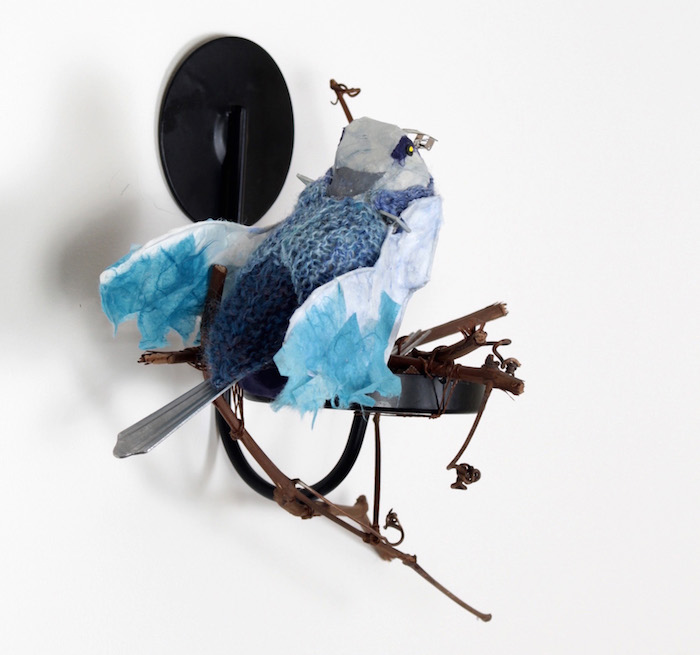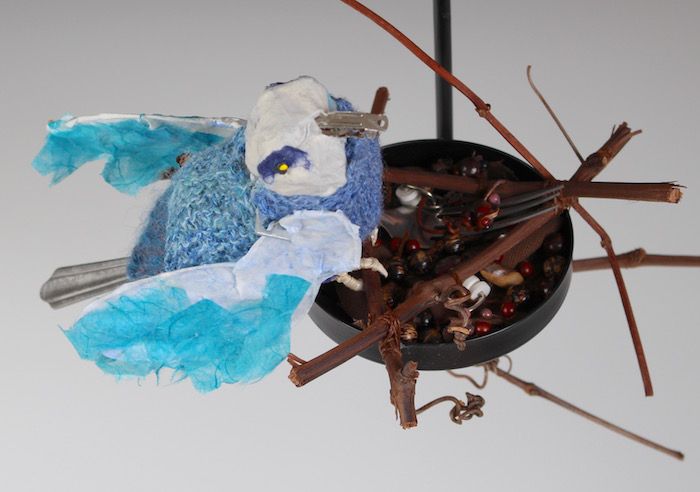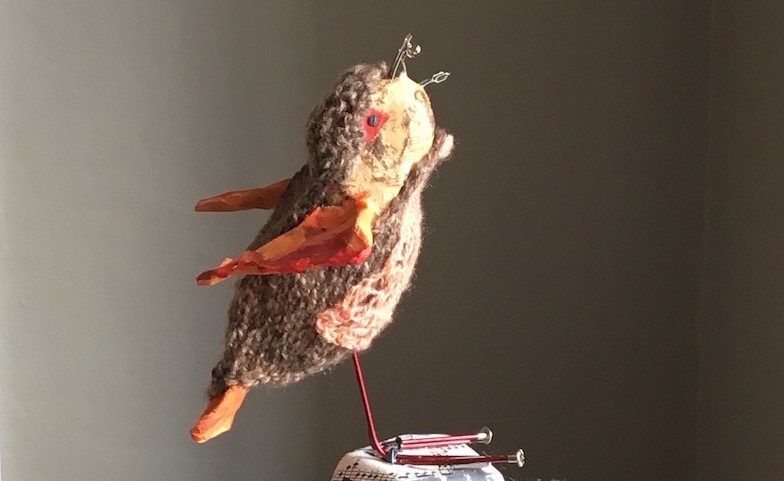“Where do you come up with ideas for your artwork?” is a common question people ask me. I pick up ideas from conversations, news stories, and observation of what’s happening around me. I jot down ideas that strike me as interesting, even if I don’t yet know how I’ll use them.
Using birds to illustrate stories about the environment
The germ of the idea for Shrill Call was a friend’s comment that shorebirds are losing their habitats at alarming rates because climate change is altering the coastal ecology. The sandy areas where they nest are disappearing.
The piece is one of many I’ve created with birds as the subject. Because birds live close to people, they are familiar to us. We see them in all environments: city, farm, forest, field, desert, ocean, mountains. This makes them good figures for illustrating the loss of natural habitats to agricultural practices and real estate development. Birds are also well-suited as characters in the story of climate change, pollution, and extinction.
People have been fascinated with birds for centuries. They probably inspired the earliest music made by humans. One of my favorite bird-inspired pieces of music is Le Merle Noir by Olivier Messiaen. I played this piece for flute and piano in a college recital. (You can listen to the short piece here.) My professor commented that I had captured the personality of the bird. I’m continuing to internalize the experience of birds.
The bird in Shrill Call is a mash-up of species; it’s not based directly on a particular bird. I used some pieces of flute music to cover the rocks where the bird is perched. It’s a not very subtle reference to bird calls. The water, with frothy waves, creeps higher and higher on the rocky perch. There is no vegetation, because the rising waters have inundated the shore.

Shrill Call, handspun wool yarn, mulberry paper, sheet music, knitting needles, barrette, acrylic paint, 13 x 14 x 14 inches, $300. © 2017 Eve Jacobs-Carnahan
Watching birds at our feeders is a way to learn science
Another reason birds are so relatable is because we see them at our bird feeders. They are like pets, but wild. We watch them up close near our windows but they never come indoors.
I am an amateur bird watcher. There are a couple dozen familiar birds I can identify, but beyond that, I dig for the field guide. That doesn’t stop me from appreciating them and trying to learn more. I really enjoy David Allen Sibley’s What It’s Like to be a Bird. The subtitle says it all: From Flying to Nesting, Eating, to Singing, What Birds are Doing and Why.

Feed the Birds, handspun yarn, mulberry paper, waxed linen, grapevine, broken fork, beads, metal objects, 10 x 11 x 7 inches, $300. © 2018 Eve Jacobs-Carnahan
Watching birds can teach you a lot about avian and plant biology, as well as ecology of forests, fields, deserts, wetlands, and oceans. As you learn about birds, you learn about what they eat, where they nest, and how they migrate. Watching birds is an entrée into the world of science. I’m familiar with two events that mobilize laypeople to collect data on the number and species of birds in particular geographic areas: the Audubon Christmas Bird Count and the Cornell lab or Ornithology February Great Backyard Bird Count. Scientists analyze the data to watch trends that can indicate the health of the bird population, and correspondingly, the health of the environment.
I used symbolic materials to illustrate this bird story
The birdfeeders in my yard were the inspiration for my wall sculpture Feed the Birds. I wanted to capture the idea that how human practices affect birds, especially practices surrounding agriculture. It’s not a literal depiction of a problem, but symbolic. I used a found object as a bird feeder. (It was originally some type of wall sconce.) I filled the tray with wooden beads that look like seeds and then threw in some miscellaneous metal objects, things that would not be good for birds to eat. The most significant is the broken fork.

Feed the Birds (detail), handspun yarn, mulberry paper, waxed linen, grapevine, broken fork, beads, metal objects, 10 x 11 x 7 inches, $300. © 2018 Eve Jacobs-Carnahan
The fork refers to the effect our agricultural practices have on the plants available for birds to eat. Huge monoculture crops that are planted in gigantic fields mean there are no native plants for birds to eat. Pesticides can harm the birds’ nervous and reproductive systems. The bird in this sculpture is showing signs of human effects: its tail has transmuted into a metal fork handle.
To see more ways I play with themes around birds, take a look at my bird gallery.

Also, I have never participated in the Christmas bird count, but I love that it happens. Just saying…
I just love these. And being a knitter of regular sized objects to wear I am so impressed by the delicacy of your stitches….
It’s deceptive. My knitting doesn’t need to fit a prescribed person’s body like wearable knitting does.
Eve, I really enjoy Shrill Call’s spirit. There is just a bit of humor and playfulness thrown in to his/her countenance. Makes me smile.
Thanks, Nel. I agree. think the barrette beak might be one way to capture playfulness.